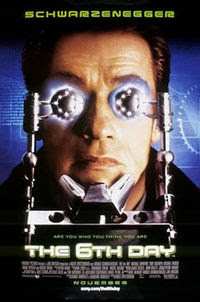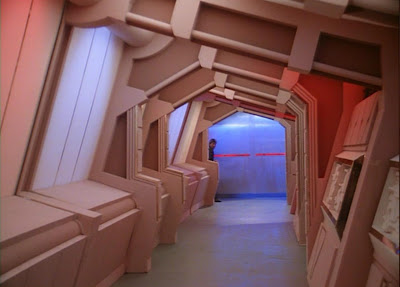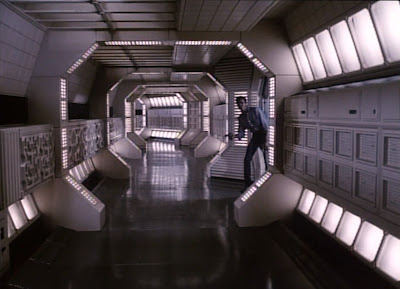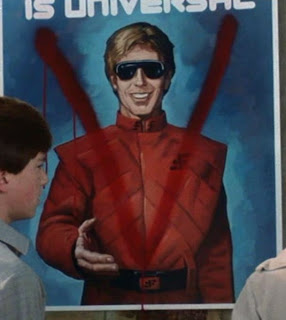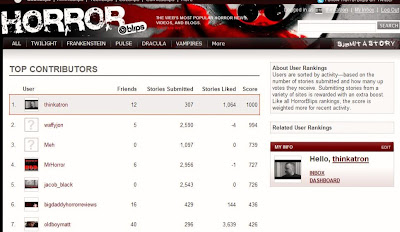- Xander (Nicholas Brendan) experiences an unpleasant memory, in "Tabula Rasa."
One of the most commonly-featured themes in cult-tv history involves the age-old, psychological debate of nature vs. nurture.
Are heroes (even Starfleet officers and C.I.A. agents) "born" heroic?
Or are their personalities and achievements the result of extensive experience and training? In other words, many genre programs over the last sixty years have grappled with the idea of heroic identity, and put their protagonists to the test.
Or are their personalities and achievements the result of extensive experience and training? In other words, many genre programs over the last sixty years have grappled with the idea of heroic identity, and put their protagonists to the test.
The most oft-depicted manner of testing this mettle, it seems, is to remove a hero's memory entirely; to cause the unlucky dramatis personae of a TV series to experience retrograde amnesia, the total loss of pre-existing memories.
In other words, if James T. Kirk (William Shatner) is zapped by an alien obelisk and loses his memory on a faraway world of Native Americans, will his new identity as "Kirok" -- a blank slate, essentially -- also feature the self-same qualities that make the starship captain so noble; namely ingenuity, leadership ability, and loyalty, etc.?
 Star Trek grappled with this amnesia paradigm and the concept of the blank slate (that people/characters could be reduced to a state of innocence, with no experience or memory...) in the above-referenced third season episode, "The Paradise Syndrome," but that's not the only example of this tale, even in the Roddenberry franchise.
Star Trek grappled with this amnesia paradigm and the concept of the blank slate (that people/characters could be reduced to a state of innocence, with no experience or memory...) in the above-referenced third season episode, "The Paradise Syndrome," but that's not the only example of this tale, even in the Roddenberry franchise.
In Star Trek: The Next Generation (1987-1994), the fourth-season episode "Clues" [ed's note: - actually "Conundrum," per reader Brian!] saw the entire crew of the Enterprise-D suffering from an induced amnesia, becoming pawns of destructive aliens in the process. Eventually, Captain Picard (Patrick Stewart) and the others began to realize "who" they were, and were able to re-assume control of the ship and re-assert their values. Just in time too...they were on a mission of terrible destruction.
A TNG episode of the seventh season, "Thine Own Self," saw a malfunctioning Data as a kind of wandering amnesiac on an alien world, so this plot device was occasionally re-used, even on that particular series.
A TNG episode of the seventh season, "Thine Own Self," saw a malfunctioning Data as a kind of wandering amnesiac on an alien world, so this plot device was occasionally re-used, even on that particular series.
More recently, Alias's (2001 - 2006) action-packed third season played the amnesia card to dynamic and thrilling effect across a wide story-arc. C.I.A. agent Sydney Bristow (Jennifer Garner) awoke in Hong Kong after a fight with an enemy spy...only to learn that two years had past and that she had no memory of her activities during that span. Her boyfriend, Vaughn (Michael Vartan) was now married.
In this case, Sydney's core identity had been mysteriously returned at her awakening, but she was forced to wonder what, precisely, she had done in those missing years. Over the course of several episodes, it was learned that Sydney had taken on a new identity as "Julia Thorne," an assassin for a nefarious organization called "The Covenant" and that, on at least one occasion, she had killed a good guy (a Russian diplomat).
So the question here was not very dissimilar from the one what Star Trek had imagined and raised in the late 1960s. Stripped of her friends, training, loyalty, and her experience, was Sydney capable of becoming...evil? Or, despite the content of her memory, was she always the good guy? Could she ever be anything other than "the chosen one" that destiny (and Rambaldi...) intended?
In this case, Sydney's core identity had been mysteriously returned at her awakening, but she was forced to wonder what, precisely, she had done in those missing years. Over the course of several episodes, it was learned that Sydney had taken on a new identity as "Julia Thorne," an assassin for a nefarious organization called "The Covenant" and that, on at least one occasion, she had killed a good guy (a Russian diplomat).
So the question here was not very dissimilar from the one what Star Trek had imagined and raised in the late 1960s. Stripped of her friends, training, loyalty, and her experience, was Sydney capable of becoming...evil? Or, despite the content of her memory, was she always the good guy? Could she ever be anything other than "the chosen one" that destiny (and Rambaldi...) intended?
A more specific, contained example of amnesia was depicted in Babylon 5 (1994 - 1999): Commander Sinclair (Michael O'Hare) could not remember a crucial 24 hours in his history (during an important space battle, no less). Finding out what happened to him in that missing spell would help to shape his very future.
 In addition to such examples, the amnesia story has also been a staple of superhero programming going back to the beginning of the medium of television itself.
In addition to such examples, the amnesia story has also been a staple of superhero programming going back to the beginning of the medium of television itself.
Way back in the early 1950s, in "Panic in the Sky," The Adventures of Superman (1951 - 1958) first dealt with the concept. In this memorable tale written by Jackson Gillis and directed by Thomas Carr, Superman loses his memory while attempting to deflect an approaching meteorite from Earth. If he does not recover his memory in time, millions of people on Earth will die.
The same amnesia tale was re-made on Lois and Clark in the 1990s as "All Shook Up" and has been repeated with some variation on The Incredible Hulk ("Mystery Man,"), The Greatest American Hero ("A Train of Thought,"), Angel ("Spin the Bottle"), Smallville ("Blank") Mutant X ("Presumed Guilty") and Painkiller Jane ("Thanks for the Memories"), to name just a few variations.
 In addition to such examples, the amnesia story has also been a staple of superhero programming going back to the beginning of the medium of television itself.
In addition to such examples, the amnesia story has also been a staple of superhero programming going back to the beginning of the medium of television itself. Way back in the early 1950s, in "Panic in the Sky," The Adventures of Superman (1951 - 1958) first dealt with the concept. In this memorable tale written by Jackson Gillis and directed by Thomas Carr, Superman loses his memory while attempting to deflect an approaching meteorite from Earth. If he does not recover his memory in time, millions of people on Earth will die.
The same amnesia tale was re-made on Lois and Clark in the 1990s as "All Shook Up" and has been repeated with some variation on The Incredible Hulk ("Mystery Man,"), The Greatest American Hero ("A Train of Thought,"), Angel ("Spin the Bottle"), Smallville ("Blank") Mutant X ("Presumed Guilty") and Painkiller Jane ("Thanks for the Memories"), to name just a few variations.
One of the finest examples of the "amnesia" story arrived on UPN in late 2001 (November 13, to be precise), and it was, not surprisingly, featured in the superhero milieu once more. Rebecca Rand Kirshner penned "Tabula Rasa" an episode of Buffy the Vampire Slayer's sixth season.
Now, if you remember this season, you might recall that the "Big Bad" villain of the year was actually real life. Recently returned from the dead, the Slayer, Buffy Summers (Sarah Michelle Gellar) had to grapple with the parenting of her teenage sister Dawn (Michelle Trachtenberg), a flooded basement ("Flooded"), and most dastardly of all, paying the bills ("Life Serial"). In one episode ("Doublemeat Palace") she had to get a dead-end job at a fast-food restaurant.
The high school as Hell-template of the first three seasons had been left behind and -- courageously and controversially -- Buffy the Vampire Slayer nudged its young characters into responsibility-filled adulthood. Xander asked Anya to marry him...then had second thoughts. Willow -- a burgeoning witch -- began to rely too heavily on magic, an addiction of sorts ("Wrecked").
Now, if you remember this season, you might recall that the "Big Bad" villain of the year was actually real life. Recently returned from the dead, the Slayer, Buffy Summers (Sarah Michelle Gellar) had to grapple with the parenting of her teenage sister Dawn (Michelle Trachtenberg), a flooded basement ("Flooded"), and most dastardly of all, paying the bills ("Life Serial"). In one episode ("Doublemeat Palace") she had to get a dead-end job at a fast-food restaurant.
The high school as Hell-template of the first three seasons had been left behind and -- courageously and controversially -- Buffy the Vampire Slayer nudged its young characters into responsibility-filled adulthood. Xander asked Anya to marry him...then had second thoughts. Willow -- a burgeoning witch -- began to rely too heavily on magic, an addiction of sorts ("Wrecked").
 "Tabula Rasa" -- again, Latin for blank slate -- finds the dramatis personae lapsing deeper into confusion, self-doubt and anger at the way life is turning out for them.
"Tabula Rasa" -- again, Latin for blank slate -- finds the dramatis personae lapsing deeper into confusion, self-doubt and anger at the way life is turning out for them. Tara (Amber Benson), Willow's girlfriend, has discovered that Willow is using magic (Lethe's Bramble) to alter her memory...so they never fight.
And Giles -- convinced that Buffy isn't living up to her responsibilities because he is always "playing" the father -- decides to leave for England permanently.
Meanwhile, the vampire Spike (James Marsters) owes a loan shark demon some kittens (currency in the underworld) and is causing problems for Buffy. Alone and unable to tell her friends about the after-life, Buffy has taken the first steps towards intimacy with Spike...kissing him (in the musical episode "Once More With Feeling," which precedes this show).
With Buffy angry about Giles' departure, and Tara threatening to leave if Willow uses magic again, Willow soon conjures a forgetting spell. But -- as these things do -- it goes wrong, and everybody (Anya, Xander, Buffy, Spike, Dawn, Giles, Willow and Tara) ends up as amnesiacs in the Magic Box.
With vampires pounding on the doors, these amnesiacs must learn quickly who they are, where they are, and what the hell they were doing before they lost their memories.
With vampires pounding on the doors, these amnesiacs must learn quickly who they are, where they are, and what the hell they were doing before they lost their memories.
Very quickly, the gang begins to seek clues about their pre-existing identities. Since Spike and Giles both have British accents, they assume they are son and father. Since Anya awakens near Giles and finds an engagement ring on her finger, she assumes Giles is her fiance.
Carrying no wallet or identification of any kind, Buffy quickly exhibits leadership qualities, but gives herself a name that deliberately eschews such responsibilities...Joan. "I feel like a Joan," she says modestly, before coming to realize (during a fight with a vampire) that she is indeed a "superhero or something." But being Joan offers Buffy, at least for a bit, the chance to hide from her true identity and responsibilities.
Carrying no wallet or identification of any kind, Buffy quickly exhibits leadership qualities, but gives herself a name that deliberately eschews such responsibilities...Joan. "I feel like a Joan," she says modestly, before coming to realize (during a fight with a vampire) that she is indeed a "superhero or something." But being Joan offers Buffy, at least for a bit, the chance to hide from her true identity and responsibilities.
Spike has an even more unpleasant reckoning. He imagines himself a hero like "Joan," only to learn that he's a vampire...a monster. "I must be a noble vampire...a good guy," he finally concludes, unwittingly comparing himself to Angel, the vampire with a soul who "helps the helpless." No such luck: he's a soulless, lovelorn demon.
Meanwhile, Willow and Tara discover that their attraction to one another (and indeed, their sexual orientation) goes beyond mere memory and experience...it's biology. They tentatively orbit one another, an experience which almost culminates with a kiss. Dawn, who is typically fearful and clingy to Buffy even as an amnesiac (they realize they are sisters...) remembers the feeling of being imperiled. It is, she says "weirdly familiar."
Interestingly, all the characters unknowingly cometo play their traditional roles before the amnesia experience is done. Xander tries to play the hero, leading Dawn to safety in the sewers (though outmatched by a vampire). Giles and Anya see to "the research" to fight the vampires with magic. And Buffy and Spike physically fight the bad guys...acting as the warriors. Even without memory, without experience, they are all destined to be these things...and they can't escape destiny.
At the end of the day, the spell is broken, and real life comes crashing back down on everyone. Tara leaves Willow for breaking her word about using magic. And Giles boards a flight for London...a one way trip.
In this case, the amnesia -- though frightening -- actually proves a respite of sorts in which these troubled characters can, for a time, hide from their true identities (and from the Big Bad of the season -- real life.) For a time, Buffy can just be Joan (a choice of names which Dawn calls "blah") and worry about what's in front of her face...not saving the world. Similarly, Spike can escape his destiny as a "monster."
At the end of the day, the spell is broken, and real life comes crashing back down on everyone. Tara leaves Willow for breaking her word about using magic. And Giles boards a flight for London...a one way trip.
In this case, the amnesia -- though frightening -- actually proves a respite of sorts in which these troubled characters can, for a time, hide from their true identities (and from the Big Bad of the season -- real life.) For a time, Buffy can just be Joan (a choice of names which Dawn calls "blah") and worry about what's in front of her face...not saving the world. Similarly, Spike can escape his destiny as a "monster."
But what "Tabula Rasa" cogently reminds the characters of Buffy the Vampire Slayer (and the viewership) is that real life is not something that can be escaped; even with amnesia. In fact, human beings are not blank slates...we are the accumulation of our choices and decisions.
And those choices and decisions are so much a part of our human gestalt that even without active recall, we cannot escape them; they re-assert themselves, as if by osmosis. Buffy is a hero...and even as Joan, she remains a hero. The daily troubles faced by Giles and Willow disappear momentarily in the crisis...but return with a vengeance once Willow's spell is broken.
Even Anya, a former vengeance demon, in her amnesiac state resorts to her true identity, taking vengeance upon Giles -- a man -- for attempting to leave her before they get to the altar (a grave foreshadowing of her actual wedding experience in "Hell's Bells.")
And those choices and decisions are so much a part of our human gestalt that even without active recall, we cannot escape them; they re-assert themselves, as if by osmosis. Buffy is a hero...and even as Joan, she remains a hero. The daily troubles faced by Giles and Willow disappear momentarily in the crisis...but return with a vengeance once Willow's spell is broken.
Even Anya, a former vengeance demon, in her amnesiac state resorts to her true identity, taking vengeance upon Giles -- a man -- for attempting to leave her before they get to the altar (a grave foreshadowing of her actual wedding experience in "Hell's Bells.")
In the end, Buffy intimates -- in one of the genre's great amnesia stories -- that we can't escape who we are; we can't deny who we are. There's no magic bullet to escape real life.
Instead, we have to face it, armed with our very identities -- with the built-in characteristics and experiences that have taught us (hopefully) to cope.
Instead, we have to face it, armed with our very identities -- with the built-in characteristics and experiences that have taught us (hopefully) to cope.
In other words, those skeletons in the closet can't be buried or ignored.
They have to be brought out into the open, into the daylight...and sword-fought to a standstill.
That's real life for you.
They have to be brought out into the open, into the daylight...and sword-fought to a standstill.
That's real life for you.



